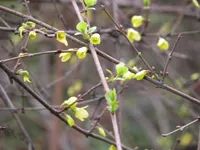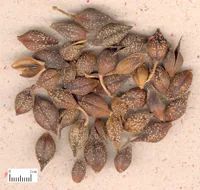Lian Qiao – Original State Lian Qiao – Medicinal Material
Lian Qiao – Medicinal Material

It is the dried fruit of the plant Lian Qiao (Forsythia suspensa (Thunb.) Vahl) from the Oleaceae family. It is produced in Northeast China, North China, the Yangtze River basin, and Yunnan. The fruit is harvested in the autumn when it is initially ripe and still green, impurities are removed, steamed, and dried, commonly referred to as “Qing Qiao”; when the fruit is fully ripe, it is harvested, dried, and impurities are removed, commonly referred to as “Lao Qiao” or “Huang Qiao”. After harvesting Qing Qiao, it is immediately steamed and dried, and the seeds are screened out for use as “Lian Qiao Xin”. It is used raw. [Properties] Bitter, slightly cold, enters the Lung, Heart, and Small Intestine meridians. [Functions] Clears heat and detoxifies, reduces swelling and disperses nodules, disperses wind-heat. [Applications] 1. For carbuncles, sores, and phlegm nodules. This product is bitter and cold, primarily entering the Heart meridian, capable of clearing Heart fire and detoxifying sores, as well as dispersing carbuncles and swelling, hence it is known as the “Holy Medicine for Sores”. It is often used in combination with Jin Yin Hua (Honeysuckle), Pu Gong Ying (Dandelion), and Ye Ju Hua (Wild Chrysanthemum) for detoxification and swelling reduction. If the carbuncles are red and swollen but not yet ulcerated, it is often combined with Chuan Shan Jia (Pangolin Shell) and Zao Jiao Ci (Soapberry Thorn), such as in the modified Xiao Du Yin (《外科真铨》); if the sores are oozing pus, red, swollen, and ulcerated, it is often used with Mu Dan Pi (Tree Peony Root) and Tian Hua Fen (Trichosanthes Root), such as in Lian Qiao Jie Du Tang (《疡医大全》); for phlegm-heat accumulation and phlegm nodules, it is often combined with Xia Ku Cao (Selfheal Spike), Zhe Bei Mu (Fritillaria), Xuan Shen (Scrophularia), and Mu Li (Oyster Shell) to clear the Liver, disperse nodules, transform phlegm, and reduce swelling. 2. For wind-heat exterior syndrome and the initial stage of warm diseases. This product is bitter and can clear and drain, cold and can clear heat, entering the Heart and Lung meridians, excelling at clearing Heart fire and dispersing wind-heat in the upper jiao. It is often used with Jin Yin Hua, Bo He (Mint), and Niu Bang Zi (Burdock Seed) to treat wind-heat exterior syndrome or the initial stage of warm diseases, with symptoms such as headache, fever, thirst, and sore throat, as in Yin Qiao San (《温病条辨》). If Lian Qiao Xin is combined with Mai Dong (Ophiopogon) and Lian Zi Xin (Lotus Seed Heart), it can also be used to treat warm diseases with heat entering the pericardium, high fever, and delirium, as in Qing Gong Tang (《温病条辨》); this product also has the function of clearing heat and transforming qi, and when used with Shui Niu Jiao (Water Buffalo Horn), Sheng Di (Rehmannia), and Jin Yin Hua, it can treat heat entering the nutritive and blood levels, with symptoms such as a red tongue, delirium, and irritability, as in Qing Ying Tang (《温病条辨》). 3. For painful urinary dribbling due to heat. This product is bitter and cold, has a descending action, and also has the function of clearing the Heart and promoting urination. It is often combined with Che Qian Zi (Plantago Seed), Bai Mao Gen (Imperata), Zhu Ye (Bamboo Leaf), and Mu Tong (Akebia) to treat urinary difficulties or painful dribbling due to damp-heat obstruction, as in Ru Sheng San (《杂病源流犀烛》). [Dosage] Decoction, 6-15g. [Cautions] Not suitable for those with spleen and stomach deficiency-cold or qi deficiency with clear pus. [Differentiation in Use] Lian Qiao is clinically differentiated into Qing Qiao, Lao Qiao, and Lian Qiao Xin. Qing Qiao has a stronger heat-clearing and detoxifying effect; Lao Qiao excels at dispersing heat to the surface and dispersing wind-heat; Lian Qiao Xin excels at clearing the Heart and draining fire, commonly used for high fever and irritability due to evil entering the pericardium. Lian Qiao and Jin Yin Hua both have heat-clearing and detoxifying effects, capable of dispersing heat to the surface and clearing internal heat and detoxifying. They are often used together for wind-heat exterior syndrome, the initial stage of warm diseases, and heat toxin sores. However, the distinguishing point is that Lian Qiao has a strong ability to clear the Heart and detoxify, and is good at dissipating carbuncles and dispersing nodules, making it the “Holy Medicine for Sores”, also treating phlegm nodules; while Jin Yin Hua excels at dispersing exterior heat and, when charred, is good at cooling blood and stopping dysentery, used for heat toxin blood dysentery. [Ancient Text Excerpts] 1. “Shen Nong’s Materia Medica”: “Mainly treats cold and heat, mouse fistula, phlegm nodules, carbuncles, sores, goiter, heat accumulation, and gu poison.” 2. “Ri Hua Zi Ben Cao”: “Treats sores and boils, stops pain.” 3. “Zhen Zhu Nang”: “The uses of Lian Qiao are three: to drain guest heat from the Heart, one; to eliminate various heats from the upper jiao, two; as the Holy Medicine for Sores, three.” [Modern Research] 1. Chemical Composition: This product contains triterpenoid saponins, the fruit peel contains sterols, Lian Qiao phenol, alkaloids, saponins, oleanolic acid, coumarin compounds, and is rich in vitamin P and contains a small amount of volatile oil. 2. Pharmacological Effects: Lian Qiao has broad-spectrum antibacterial effects, with the main antibacterial components being Lian Qiao phenol and volatile oil, which have strong inhibitory effects on Staphylococcus aureus and Shigella, and also have certain inhibitory effects on other pathogenic bacteria, influenza viruses, and Leptospira; this product has anti-inflammatory and antipyretic effects. The oleanolic acid contained has cardiotonic, diuretic, and blood pressure-lowering effects; the vitamin P can reduce vascular permeability and fragility, preventing hemolysis. Its decoction has antiemetic and hepatoprotective effects. 3. Clinical Research: Reports indicate that Lian Qiao is commonly used for acute respiratory infections and acute skin suppurative infections, and can also be used for various other diseases. For example, Lian Qiao combined with Huang Qin (Scutellaria), Yan Hu Suo (Corydalis), Bing Pian (Borneol), and Zi Cao (Lithospermum) was mixed into a powder and sprinkled on ulcer surfaces to treat 126 cases of oral ulcers in children, with a total effective rate of 88% (Shanghai Journal of Traditional Chinese Medicine 1995, 12:29); using Lian Qiao as the main ingredient combined with Huang Qin and Da Qing Ye (Isatis Leaf) to prepare an injection, intramuscular injection, to treat 60 cases of psoriasis, with a total effective rate of 80%, and no adverse reactions observed (New Applications of Traditional Chinese Medicine 2001:324); using Lian Qiao decocted in water and taken orally before meals three times a day to treat 283 cases of retinal vein and artery thrombosis, of which 216 cases had hemorrhage in the macular area, with significant improvement in vision and alleviation of scotoma symptoms, with an effective rate of 93% (Journal of Traditional Chinese Medicine 1998, 3:37). In addition, Lian Qiao can also be used to treat cervical lymphadenitis, acute infectious hepatitis, allergic purpura, acute nephritis, as well as vomiting and constipation.

